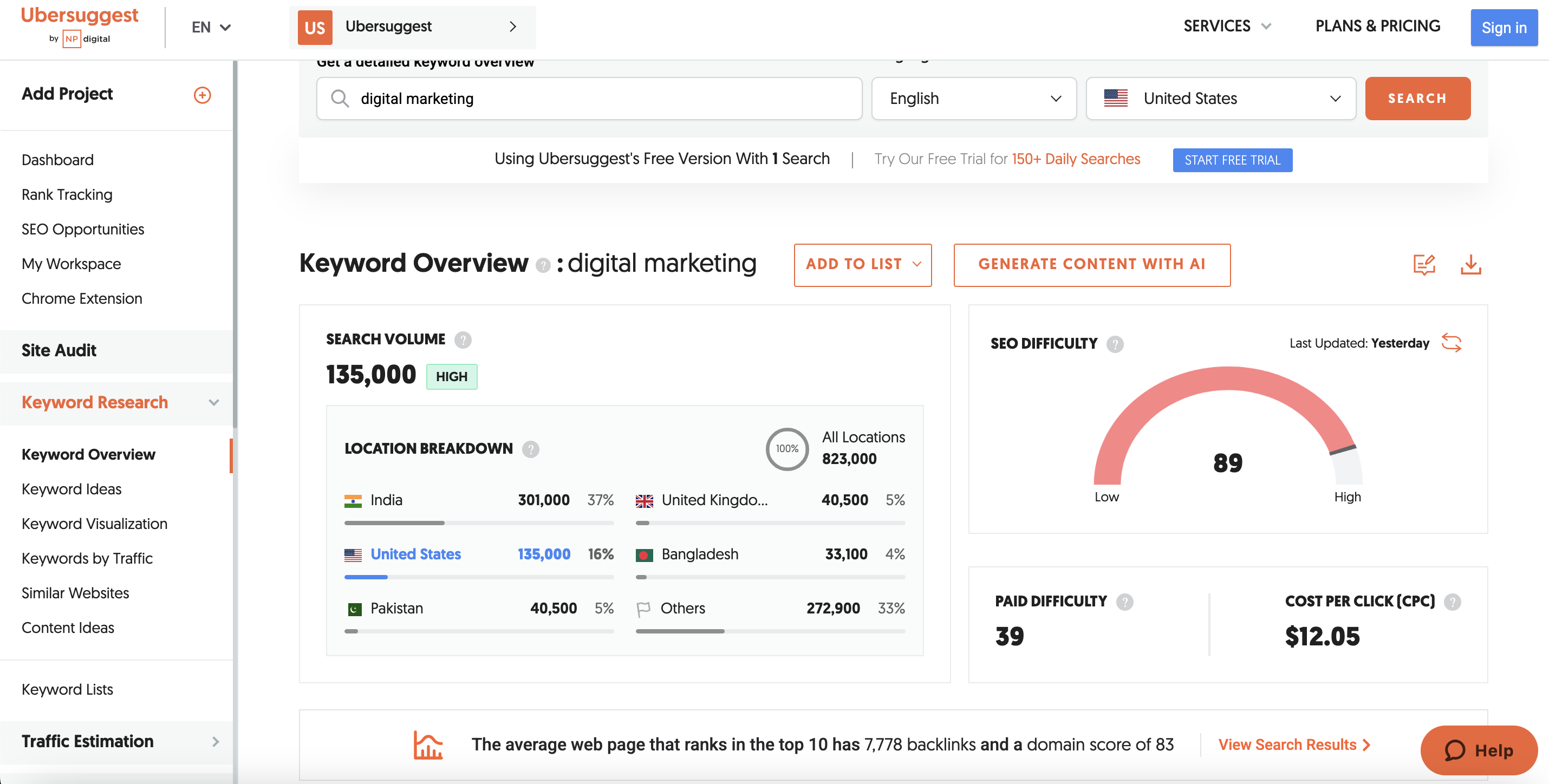Ubersuggest Keyword Tool: How to Find High-Volume, Low-Competition Keywords

Introduction
Are you tired of spending countless hours creating content that nobody sees? Do you dream of unlocking the secret to finding profitable keywords that drive organic traffic to your website? Learn how to use Ubersuggest’s keyword tool to uncover high-volume, low-competition keywords – the key to a successful content strategy. At Growth-Metric, we’ve used Ubersuggest extensively, and we’re ready to share our proven strategies with you. This guide is perfect for both beginners and seasoned SEO professionals looking to refine their keyword research process.
Tool Stack Essentials
While Ubersuggest is our primary recommendation for keyword research, building a robust SEO strategy requires a complementary toolset. Here’s our recommended stack, combining free and paid options:
Ubersuggest (Keyword Research): Ubersuggest goes beyond simply suggesting keywords. It provides comprehensive data on keyword volume, competition, search intent, and related keywords, making it ideal for uncovering hidden gems. Their suggestions align with Google search algorithm’s changes, ensuring up to date suggestions.
SEMrush (Competitive Analysis & SEO Auditing): In addition to its keyword research capabilities, SEMrush offers powerful tools for competitive analysis (see what keywords your competitors rank for), website audits (identifying SEO weaknesses), and backlink analysis. While more expensive than Ubersuggest, its comprehensive suite of tools makes up for the higher price point.
Google Search Console (Website Monitoring & Indexing): This free tool provides invaluable data about your website’s performance in Google search results. Monitor your rankings, identify technical issues impacting SEO, and keep tabs on how Google sees your website.
Google Analytics (Website Traffic Analysis): Another free tool provided by Google, it is essential for tracking the performance of your website and the effectiveness of your SEO strategy. You can use Google Analytics to see exactly where your keywords are generated, and how visitors are interacting with your page.
Implementation Timeline
Implementing a robust keyword research strategy using Ubersuggest doesn’t require months of work. With focused effort, you can see results quickly:
- Week 1: Familiarize yourself with Ubersuggest’s interface. Perform initial keyword research for your top 3-5 target topics.
- Week 2: Analyze your competitor’s keyword strategies using SEMrush. Begin to refine your initial keyword list based on your analysis. Integrate Google Search Console and Google Analytics for consistent monitoring.
- Week 3: Start creating and publishing content optimized for your top-performing keywords. Monitor your rankings and website traffic regularly.
- Week 4: Analyze the performance of your existing website content. Refine your keyword strategy based on data collected from your website’s new page performance.
By following this timeline, many users report a 2x increase in organic traffic within three months – a significant return on investment for time spent.
Step-by-Step Guide
Step 1: Identifying Your Niche and Initial Keywords
Before diving into Ubersuggest, clarify your niche and brainstorm initial keywords related to your business and target audience. For example, if you sell handmade jewelry, start by listing terms like “handmade earrings,” “beaded necklaces,” “custom bracelets,” etc.
Step 2: Using Ubersuggest’s Keyword Idea Generator
Enter your initial keywords into Ubersuggest’s Keyword Idea Generator. The tool will provide a list of related keywords, including keyword difficulty (KD) scores and search volume. Filter for low KD scores (meaning lower competition) and high search volume (meaning more potential traffic).
Step 3: Analyzing Keyword Difficulty and Search Volume
Ubersuggest assigns a KD score to each keyword. A score of 0-20 suggests relatively low competition. You should focus on keywords in this range. Simultaneously, pay attention to search volume. Aim for keywords with high monthly search volume numbers. Even low KD keywords won’t be useful without sufficient search volume.
Step 4: Evaluating Keyword Intent
Ubersuggest helps identify the search intent behind each keyword. Are people searching for information (informational intent), looking to buy a product (commercial intent), or navigating to a specific website (navigational intent)? Align your content with the appropriate search intent. If your keyword has commercial intent, don’t waste time with informational content.
Step 5: Refining Your Keyword List
Once you’ve evaluated numerous keywords, choose a final selection that aligns with your business goals and content strategy. Prioritize keywords with high search volume, low KD, and clear search intent. Continuously refine your keyword list based on the performance of your content and changes in search trends.
Step 6: Monitoring and Refining Your Strategy
Use Google Analytics and Google Search Console to monitor the success of your keywords. Track your website’s organic traffic, keyword rankings, and click-through rates (CTR). Fine-tune your strategy. What keywords are your organic traffic from? Which aren’t doing well? Make changes based on your data.
Key Metrics to Track
Tracking several metrics will allow you to see how well your Ubersuggest keyword strategy is actually working. Here is a list of metrics to focus on:
- Organic Traffic: The number of visitors coming to your site from search engines. Google Analytics shows you this data.
- Keyword Rankings: The position of your web pages in search engine results pages (SERPs) for your target keywords. Track these rankings using SEMrush or a similar tool.
- Click-Through Rate (CTR): The percentage of people who click on your search results listing after seeing it. This metric helps show how good your search engine snippet is (title tags and meta description).
- Conversion Rate: The percentage of website visitors who complete a desired action (e.g., making a purchase, signing up for a newsletter).
- Return on Investment (ROI): Calculate the return on your SEO efforts, keeping track of the amount spent on tools and content creation versus the revenue generated from your website.
Budget-Friendly Alternatives
If you’re on a tight budget, some excellent free or lower-cost alternatives exist:
- Google Keyword Planner: While not as comprehensive as Ubersuggest, Google Keyword Planner still provides relevant keyword suggestions and search volume data. It’s a great starting point for early-stage startups.
- Free versions of tools: Many tools, like Ubersuggest and SEMrush, offer free versions or trials with limited functionality. These trials can be used to perform short-term analysis and test out the tool before committing to a paid subscription.
Serving Your Growth Goals
Adapting your keyword research strategy according to your company’s specific business size or industry is crucial. Consider these factors:
- Startups: Focus on long-tail keywords (more specific phrases with lower competition) to target niche audiences.
- Established Businesses: Target a broader range of keywords, including short-tail keywords (more general terms with higher competition), to reach a wider audience.
- E-commerce: Prioritize keywords with commercial intent (users actively searching for products or services to buy) to drive sales conversions.
- Bloggers: Focus on informational keywords to attract readers and establish yourself as an authority in your niche.
Common Mistakes to Avoid
Avoid these common pitfalls when using Ubersuggest and other SEO tools:
- Keyword Stuffing: Don’t overload your content with keywords; focus on natural language and user experience.
- Ignoring Search Intent: Make sure your content matches the intent of the searchers. Don’t give an informational answer to a commercial question.
- Lack of Monitoring: Regular monitoring of your keywords’ performance is key to adapting your strategy over time.
- Ignoring Technical SEO: Technical SEO issues (site speed, mobile-friendliness, etc.) can hinder your SEO performance regardless of your keyword selection.
Scaling Strategies (H2)
As your business grows, take these steps to elevate your keyword research:
- Automate your processes: Many platforms handle keyword research, content creation, scheduling, and analytics automatically.
- Train your team: Give your teams the skills and training they need to run SEO programs. Ensure everyone contributes to ongoing success.
- Invest in advanced tools: Tools like SEMrush offer advanced features, helping analyze large numbers of keywords quickly and identify previously overlooked opportunities.
Conclusion
Mastering Ubersuggest’s keyword tool is a game-changer for your content strategy. By following this data-driven guide, you can significantly improve your website’s organic traffic and reach a larger audience. Remember, consistent monitoring and adaptation are key to long-term SEO success. Download our free keyword research template to jumpstart your journey! [Link to Template]
FAQs (H2)
- Q: Which tool is best for early-stage startups? A: For early-stage startups, Google Keyword Planner or the free versions of Ubersuggest or SEMrush provide an excellent starting point.
- Q: How to prioritize tool spending? A: Start with a free tool to generate initial keywords and assess the value. Gradually increase your budget to advanced tools such as SEMrush as your business and organic traffic grow.
- Q: Can I use Ubersuggest for local SEO? A: Yes. Ubersuggest allows you to target specific locations so you can find local keywords.
- Q: How often should I update my keyword strategy? A: At a minimum, update your keyword strategy every 3 months. Regularly watch your Google Search Console and Analytics for any new trends or opportunities.
This comprehensive guide will assist you in leveraging Ubersuggest effectively to discover profitable keywords and dominate search engine results. Remember to combine this strategy with exceptional content tailored to your target audience to maximize your results.
